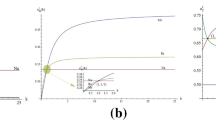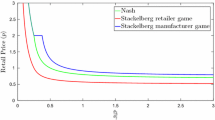Abstract
Extant studies of cooperative advertising mainly consider a single-manufacturer-single-retailer channel structure. This can provide limited insights, because a manufacturer, in real practices, usually deals with multiple retailers simultaneously. In order to examine the impact of the retailer’s multiplicity on channel members’ decisions and on total channel efficiencies, this paper develops a multiple-retailer model. In this model, the manufacturer and the retailers play a Stackelberg game to make the optimal advertising decisions. Based on the quantitative results, it is observed that: 1) When there are multiple symmetric retailers, as the number of retailers scales up, the manufacturer’s national advertising investment contributes increasingly to add to channel members’ profits in equilibrium, but the total channel efficiency deteriorates quickly and converges down to a certain value; 2) When there are multiple asymmetric retailers, the distribution channel suffers from the manufacturer’s uniform participation strategy due to the retailer’s free-riding, and benefits with the manufacturer’s retailer-specific participation strategy. This study derives equilibrium solutions in closed form for all games considered and measures explicitly the gains/losses of channel efficiencies under different game settings.
Similar content being viewed by others
References
Bergen, M. & John, G. (1997). Understanding cooperative advertising participation rates in conventional channels. Journal of Marketing Research, 34(3): 357–369
Berger, P.D. (1972). Vertical cooperative advertising ventures. Journal of Marketing Research, 9(3): 309–312
Berger, P.D. & Magliozzi, T. (1992). Optimal co-operative advertising decisions in direct-mail operations. Journal of the Operational Research Society, 43(11): 1079–1086
Chintagunta, P.K. & Jain, D. (1992). A dynamic model of channel member strategies for marketing expenditures. Marketing Science, 11(2): 168–188
Dant, R.P. & Berger, P.D. (1996). Modeling cooperative advertising decisions in franchising. Journal of the Operational Research Society, 47(9): 1120–1136
Davis, R.A. (1994). Retailers open doors wide for co-op. Advertising Age, 1: 30
Elkin, T. (2001). Intel inside at 10. Advertising Age, 72: 4 and 31
Furman, J. (2005). Wal-Mart: a progressive success story. Available via DIALOG. http://www.americanprogress.org/kf/walmart_progressive.pdf. Cited Jannuary, 2011
He, X., Prasad, A. & Sethi, S.P. (2009). Cooperative and advertising in a dynamic stochastic supply chain: feedback Stackelberg strategies. Production and Operations Management, 18(1): 78–94
Huang, Z. & Li, S.X. (2001). Co-op advertising models in a manufacturer-retailer supply chain: a game theory approach. European Journal of Operational Research, 135(3): 527–544
Jorgensen, S., Sigue, S.P. & Zaccour, G. (2000). Dynamic cooperative advertising in a channel. Journal of Retailing, 76(1): 71–92
Jorgensen, S. & Zaccour, G. (2003). A differential game of retailer promotions. Automatica, 39(7): 1145–1155
Karray, S. & Zaccour, G. (2007). Effectiveness of coop advertising programs in competitive distribution channels. International Game Theory Review, 9(2): 151–167
Kim, S.Y. & Staelin, R. (1999). Manufacturer allowances and retailer pass-through rates in a competitive environment. Management Science, 18(1): 59–76
Lal, R. (1990). Improving channel coordination trough franchising. Marketing Science, 9(4): 299–318
Lyon, L. (1932). Advertising Allowances. The Brookings Institution, Washington DC
Moulin, H. (1986). Game Theory for the Social Sciences. New York University Press, New York
Nagler, M.G. (2006). An exploratory analysis of the determinants of cooperative advertising participation rates. Marketing Letters, 17(2): 91–102
Nerlove, M. & Arrow, K.J. (1962). Optimal advertising policy under dynamic conditions. Economica, 29(114): 129–142
Simon, J.L. & Arndt, J. (1980). The shape of the advertising function. Journal of Advertising Research, 20(4): 11–28
Sigue, S.P. & Chintagunta, P. (2008). Advertising strategies in a franchise system. European Journal of Operational Research, 198(2): 655–665
Somers, T.M., Gupta, Y.P. & Herriott, S.R. (1990). Analysis of cooperative advertising expenditures: a transfer-function modeling approach. Journal of Advertising Research, 30(5): 35–45
Szmerekovsky, J.G. & Zhang, J. (2009). Pricing and two-tier advertising with one manufacturer and one retailer. European Journal of Operational Research, 192(3): 904–917
Taboubi, S. & Zaccour, G. (2002). Impact of retailer’s myopia on channel’s strategies. In: Zaccour, G. (eds.), Optimal control and differential games: essays in honor of Steffen Jorgensen, pp. 179–192. Kluwer Academic Publishers
Taboubi, S. & Zaccour, G. (2005). Coordination mechanisms in marketing channels: a survey of game theory models. Les Cahiers du GERAD, G-2005-36
Topkis, D.M. (1979). Equilibrium points in nonzero-sum n-person submodular games. SIAM Journal on Control and Optimization, 17(6): 773–787
Xie, J. & Wei, J.C. (2009). Coordinating advertising and pricing in a manufacturer-retailer channel. European Journal of Operational Research, 197(2): 785–791
Young, R.F. & Greyser, S.A. (1983). Managing Cooperative Advertising: a Strategic Approach. Lexington Books, MA
Yue, J., Austin, J., Wang, M.C. & Huang, Z. (2006). Coordination of cooperative advertising in a two-level supply chain when manufacturer offers discount. European Journal of Operational Research, 168(1): 65–85
Author information
Authors and Affiliations
Corresponding author
Additional information
This research was partially supported by the Natural Science Foundation of China (Grant No.70971072 and No. 71031005).
Jihua Zhang is a PhD candidate at the Department of Mathematical Sciences, Tsinghua University, Beijing, China. He received his BSc degree in Applied Mathematics in 2006 from Tsinghua University, and his second BSc degree in Economics in 2009 from Peking University. His current research interests lie in the field of supply chain management and marketing.
Jinxing Xie is a professor at the Department of Mathematical Sciences, Tsinghua University, Beijing, China. He received his BSc degree in applied mathematics in 1988 and his PhD degree in computational mathematics in 1995, both from Tsinghua University. He has the experience of working at Shanghai Baoshan Steel Group as a production planning and scheduling engineer for two years (1988–1990). His current research interests lie in the field of logistics and supply chain management, and production planning and scheduling. He served at the editorial review team of Decision Sciences from 2005 to 2010, and served as the associate editor for International Journal of Applied Management Sciences since 2007. He is an executive council member of the China Society for Industrial and Applied Math since 2004 and the International Community for Teachers of Mathematical Modeling and Applications since 2005.
Rights and permissions
About this article
Cite this article
Zhang, J., Xie, J. A game theoretical study of cooperative advertising with multiple retailers in a distribution channel. J. Syst. Sci. Syst. Eng. 21, 37–55 (2012). https://doi.org/10.1007/s11518-011-5165-y
Published:
Issue Date:
DOI: https://doi.org/10.1007/s11518-011-5165-y




